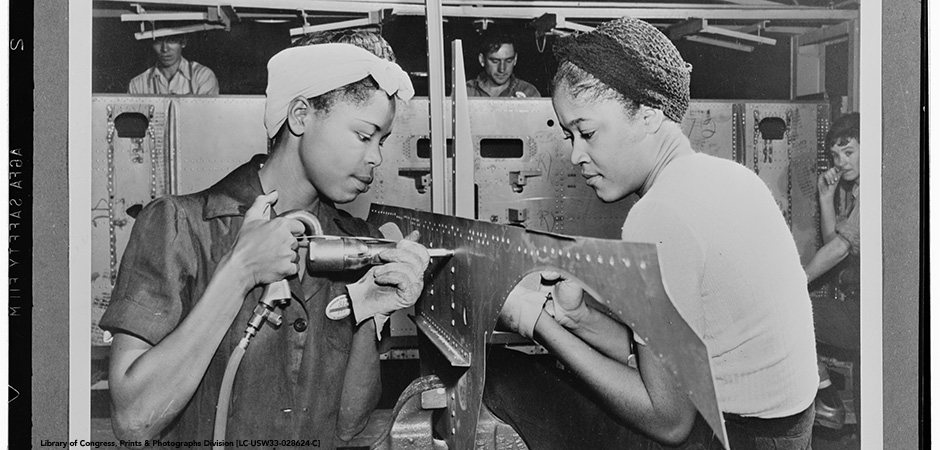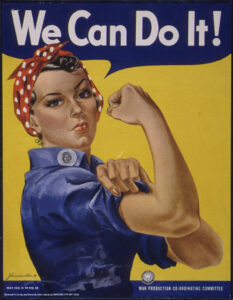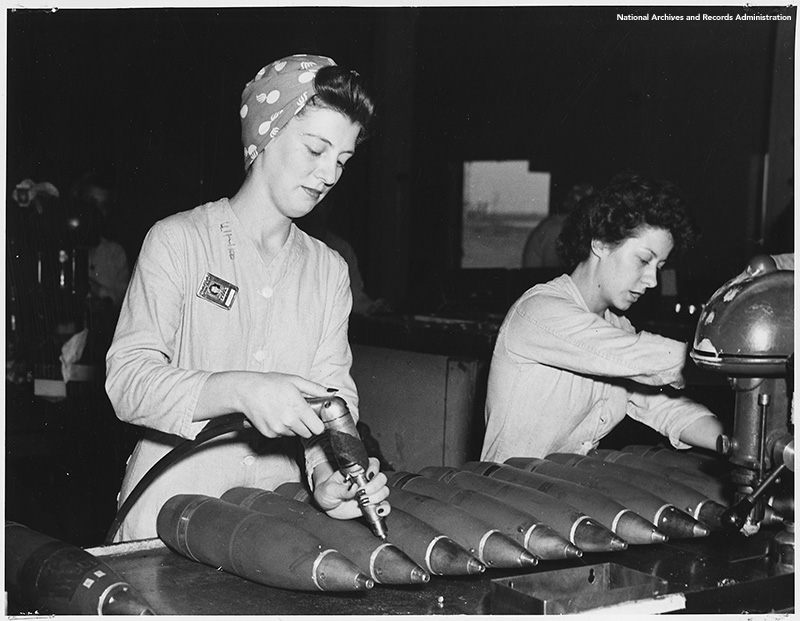
After more than 80 years, Rosie the Riveter and her “We Can Do It!” slogan remains an inspirational symbol for many. A riveter is someone whose job is to fasten things using rivets, or metal pins. This type of job is common in shipbuilding–a critical industry during the United States’ World War II mobilization. The image of Rosie the Riveter was created as a part of a patriotic campaign to recruit women to join the workforce during World War II. Rosie was typically depicted as a strong woman in a red and white polka dot bandana and blue mechanic coverall uniform. She was featured in wartime propaganda posters, movies, newspapers, articles, and songs.

Rosie the Riveter represents millions of real-life women who went to work during World War II. These women worked a variety of jobs that were previously done by men. Women were primarily employed in factories and shipyards. Between 1940 and 1945, the percentage of women in the U.S. workforce increased from 27 to 37 percent. The aircraft industry saw the greatest increase of women workers. More than 310,000 women worked in this industry in 1943, making up 65 percent of the industry’s total workforce. By comparison, in the pre-war years women only represented 1 percent of the aviation industry’s workforce. Women’s contributions to these industries aided the war effort by keeping the economy moving when American men were serving overseas as soldiers. Because so many women entered the workforce at this time, Rosie also represented change and independence. She became a well-loved symbol for women’s rights in the post-war period.
A Campaign for Remembrance
While Rosie the Riveter is an enduring cultural icon, the actual women who joined the workforce during the war have not been well-remembered until recent years. Many of the real-life “Rosies” are now in their nineties or over 100 years old. Two former Rosies, Phyllis Gould and Mae Krier, have led a successful lobbying campaign to achieve recognition for the millions of women who joined the workforce during the war.

Beginning in the 1990s, Gould started a letter writing campaign seeking White House acknowledgment for these women. She used pink paper and stickers to get noticed. It worked! In 2014, then Vice President Joe Biden received one of the letters. He invited Gould to Washington, D.C., to meet him. In 2017, Krier led a campaign to get Congress to vote for a National Rosie the Riveter Day. This day is now celebrated annually on March 21 to recognize the part women played in the United States’ victory in World War II.
Gould and Krier did not stop there. In 2019, they worked with U.S. Representative Jackie Speier to introduce the Rosie the Riveter Congressional Gold Medal Act. The bill authorized a single group Congressional Gold Medal for Rosie the Riveter. The medal symbolically honored all the women who served the country through employment or volunteerism during World War II. The bill recognized the service of these women who built the aircraft, vehicles, weaponry, ammunition, and other items needed to win the war. The bill also honored the fact that “Rosies” have inspired generations of American women. The bill was approved by both Houses of Congress on November 12, 2020. The final medal design shows five different “Rosies” of various ethnicities standing together. The medal was given to the Smithsonian Institution’s National Museum of American History.
On March 27, 2023, as part of Women’s History Month, a group of 11 surviving Rosies were given an honor flight to Washington, D.C., to celebrate their contributions. Typically, honor flights are trips to Washington, D.C. given to veterans to acknowledge their service. On their trip, the Rosies met lawmakers on Capitol Hill. They were also taken on a tour of national landmarks, such as the suffragette statue in the Capitol Building and the World War II memorial. The Rosies were then honored with a dinner and reception at Boeing’s headquarters. This was a fitting setting because the Boeing aircraft company had hired Krier to build B-17 and B-29 bomber planes when she first joined the workforce all those years ago.
